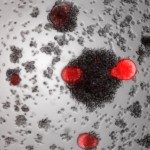Link to Pubmed [PMID] – 23084924
Cell Host Microbe 2012 Oct;12(4):585-97
The expression of hundreds of interferon-stimulated genes (ISGs) causes the cellular “antiviral state” in which the replication of many viruses, including HIV-1, is attenuated. We conducted a screen for ISGs that inhibit HIV-1 virion production and found that 2′,3′-cyclic-nucleotide 3′-phosphodiesterase (CNP), a membrane-associated protein with unknown function in mammals has this property. CNP binds to the structural protein Gag and blocks HIV-1 particle assembly after Gag and viral RNA have associated with the plasma membrane. Several primate lentiviruses are CNP-sensitive, and CNP sensitivity/resistance is determined by a single, naturally dimorphic, codon (E/K40) in the matrix domain of Gag. Like other antiretroviral proteins, CNP displays interspecies variation in antiviral activity. Mice encode an inactive CNP variant and a single amino acid difference in murine versus human CNP determines Gag binding and antiviral activity. Some cell types express high levels of CNP and we speculate that CNP evolved to restrict lentivirus replication therein.
